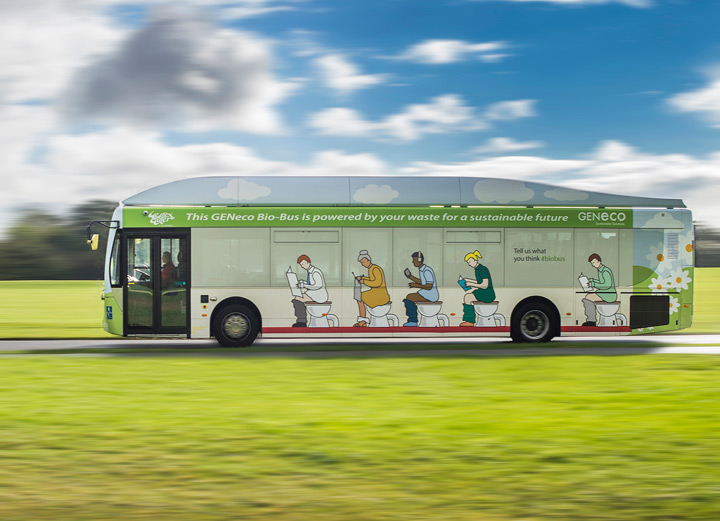Everybody poops. The average person produces between 100 and 250 grams of excrement per day, according to the Encyclopedia Britannica. But are we flushing a potential energy source down the toilet every day? Maybe.

Excrement is powering projects all over the world. Here are a few of the most interesting ones.
Bristol’s “Bio-Bus”
The Bio-Bus, which made its first trip on Thursday, is powered by gas generated through sewage treatment and food waste. It took passengers from the UK’s Bristol Airport to the city of Bath.
According to George Keast, spokesperson for Wessex Water, the company behind the project, a tank of biomethane costs less than half what a full tank of diesel would, and the bus can travel up to 300 km on a full tank. It also produces 97 per cent less exhaust than a diesel bus, he says, and has a lower carbon footprint.
And, he says, biomethane is odourless and colourless, “So no smell is emitted from the Bio-Bus.”
There are no plans to expand the Bio-Bus service right now, he says.
Oslo’s green garbage trucks
But it could be done: the city of Oslo, Norway is currently producing biogas for 100 heavy vehicles, mostly garbage trucks, and 39 buses from local sewage. The city says it could run 500 buses with fuel generated from residents’ food and sewage waste.
On its website, the city of Oslo states that the biogas buses are not only cleaner than diesel ones, they’re also quieter. Eventually, the city wants all of its municipal vehicles to be powered by low-emissions technologies, such as biofuel, electricity or hydrogen.
Japan’s toilet-cycle
More of a marketing gimmick than a serious transportation project, Japan’s toilet-motorcycle is nonetheless too fun not to mention. Or at least the commercials are.
Made by luxury toilet-manufacturer Toto (whose toilets often have buttons that heat the seat, spray water precisely onto the nether region of your choice, and even spritz deodorizer), the “Toilet Bike Neo” toured Japan in 2011 and 2012.
Even though the seat is a toilet, the motorcycle is not directly powered by the rider’s waste: like Oslo and Bristol’s buses, it runs on biogas.
Vancouver’s district heating
One legacy of the 2010 Vancouver Winter Olympics is the False Creek Energy Centre, which provided heat to the Olympic Village. It does this by drawing heat from raw sewage.
The raw sewage is warm because of the hot water from people’s showers and kitchens, which they wash down the drain, says Brian Crowe, director of Water, Sewers and District Energy for the City of Vancouver. As it flows through Vancouver’s sewers, it’s usually between 12 and 20 degrees Celsius. When it reaches a sewage pump, some of the warm sewage is diverted, screened, and directed into a heat pump. The heat pump, with a little electricity, heats up some water, which is then pumped into radiators around Southeast False Creek.
The system currently provides heat to between 8,000 and 10,000 residents, who live in surrounding apartment and mixed-use buildings. The city is planning to expand it to serve 20,000 people.
Cost-wise, it’s a bit more expensive for consumers than natural gas, says Crowe, and currently a bit cheaper than electric baseboard heating. But that’s not the most important thing, he says.
“The primary driver to do it is carbon reduction.” The city estimates that this system emits two-thirds less carbon than traditional heating systems would have
Zoo poo power
Of course, biogas doesn’t just have to come from humans. A Toronto co-operative plans to generate electricity using food waste and the manure produced by the various creatures living at the Toronto Zoo.
3,000 tonnes of manure and 14,000 tonnes of grocery store food waste will be converted into enough electricity to power 250 homes every year, according to ZooShare’s website. The energy will also be used at the zoo itself.
The co-operative has raised over $1 million so far and the facility is planned to be up and running by December 2015.
From poop to fuel
And how exactly is excrement converted into the kind of fuel which can drive a car?
It’s all done with bacteria. In a sealed, oxygen-free tank, bacteria break down the organic compounds, turning them into a gas, mostly methane and carbon dioxide. Then, this gas is purified to remove toxic substances such as hydrogen sulphide. Finally, the gas is “upgraded” to remove most of the carbon dioxide, leaving mostly methane. It can then be used like natural gas. Or, if some of the carbon dioxide remains, it can power properly-designed engines or appliances.
Although it’s not as cheap as natural gas, biogas and biomethane has a lower carbon footprint, and captures and destroys methane gas that might otherwise be released into the atmosphere. Leftover solids from the bacterial digestion process can be used as fertilizer.
Along with the examples in this article, biogas is used in small projects all over the world.


Comments